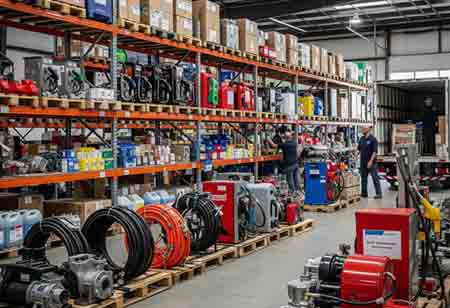Thank you for Subscribing to Energy Business Review Weekly Brief
Innovation in Fuel Handling: The Technologies Reshaping Gas Station Supplies

By
Energy Business Review | Thursday, June 05, 2025
Stay ahead of the industry with exclusive feature stories on the top companies, expert insights and the latest news delivered straight to your inbox. Subscribe today.
The distribution of gas station supplies and fuel handling equipment is driven by technological advancements that promise a more efficient and sustainable future, evolving consumer behaviors, and a global shift towards energy diversification. Distributors in this sector are adapting to a market, focusing on innovation, efficiency, and expanded service offerings to remain relevant and competitive.
Evolution of Fuel Dispensing and Handling
The heart of any gas station—the fuel dispenser—has undergone a significant evolution, primarily due to technological advancements. Modern dispensers are now more sophisticated than ever, integrating advanced electronics and digital capabilities. The standardization of contactless payment systems, including mobile payment applications and tap-to-pay options, has significantly enhanced consumer convenience and speed. The integration of cloud-based fuel management systems has enabled real-time data on fuel usage, sales, and inventory, empowering distributors to provide solutions that optimize operational efficiency for their clients. The emergence of predictive maintenance features, often powered by the Internet of Things (IoT) and Artificial Intelligence of Things (AIoT), allows for proactive servicing of equipment, thereby minimizing downtime. This not only enhances the customer experience but also significantly improves profitability for station operators.
Beyond the dispenser, the entire fuel handling infrastructure is seeing upgrades. Underground and above-ground storage tanks are incorporating more robust monitoring systems for leak detection and inventory management, ensuring environmental compliance and preventing product loss. Pumps and hoses are designed for greater durability and efficiency, often featuring lighter materials and ergonomic designs for ease of use. Vapor recovery systems remain a crucial component, continually evolving to meet increasingly stringent environmental regulations. The emphasis is on systems that are not only reliable and safe but also contribute to a cleaner and more sustainable operation.
The Rise of Multi-Energy Hubs
One of the most significant trends impacting the distribution of gas station supplies is the emergence of alternative fuels. While gasoline and diesel remain prevalent, the increasing adoption of electric vehicles (EVs) and the growing interest in hydrogen fuel cells, compressed natural gas (CNG), and liquefied petroleum gas (LPG) are reshaping the industry. Distributors are expanding their portfolios to include EV charging stations, ranging from standard AC chargers to high-speed DC fast chargers. This requires expertise in electrical infrastructure and energy management solutions. Similarly, the distribution of equipment for hydrogen fueling stations, although still in its early stages, is a growing area that demands specialized knowledge in high-pressure systems and safety protocols.
This diversification is transforming traditional 'gas stations' into 'energy hubs,' where consumers can access various fuel types. For distributors, this means a broader range of products, more complex installation requirements, and the need for technicians skilled in diverse energy systems. The focus is shifting from solely petroleum-based equipment to comprehensive energy solutions that cater to a mixed fleet of vehicles.
The Convenience Store Transformation
Integral to the modern gas station is the convenience store, which has evolved far beyond a simple stop for snacks and beverages. These retail spaces are evolving into sophisticated retail destinations, contributing a significant portion of a station's profitability. Distributors are therefore supplying a wider array of equipment for these evolving stores, including advanced point-of-sale (POS) systems, digital signage for advertising and promotions, sophisticated refrigeration and freezing units for fresh food offerings, and even equipment for made-to-order food services. The trend is towards providing high-quality, fresh food options, coffee programs, and an overall elevated in-store experience to attract and retain customers who are spending more time at the station, especially while their electric vehicles (EVs) charge. This involves a deeper understanding of retail design, merchandising, and customer flow.
Supply Chain Dynamics and Operational Efficiency
The supply chain for gas station supplies and fuel handling equipment is a complex global network, and distributors play a crucial and valued role in managing this complexity. They ensure the timely and efficient delivery of a vast range of products, from large-scale storage tanks to intricate electronic components. Factors influencing the supply chain include the availability of raw materials, manufacturing capabilities, and global shipping logistics. Distributors are increasingly leveraging technology to enhance efficiency and reduce lead times through improved inventory management, demand forecasting, and logistics optimization. Strong relationships with manufacturers and a robust distribution network are paramount to success in this environment. The emphasis is on lean supply chain practices that minimize waste and maximize responsiveness to market demands.
The future for gas station supplies and fuel handling equipment distributors holds promise for steady growth, marked by continuous adaptation and innovation. The market is projected to experience steady growth, driven by ongoing investments in infrastructure development, particularly in emerging economies, as well as the continuous upgrade of existing stations to meet modern demands. Key trends shaping the future include the further integration of smart technologies, such as AIoT, for predictive maintenance and optimized fuel management, the expansion of multi-fuel dispensers, and the continued shift towards electric vehicle charging infrastructure.
Distributors will need to remain agile, embracing new technologies and expanding their expertise to cater to a diverse energy landscape. This includes offering solutions that support not only traditional fuels but also a growing range of alternative energy options. The focus will be on providing comprehensive solutions that enhance operational efficiency, improve safety, and deliver a superior customer experience, transforming fuel stations into integrated energy and service hubs for the future. The ability to consult with clients on future-proofing their sites and integrating diverse revenue streams will be a key differentiator in this evolving industry.






